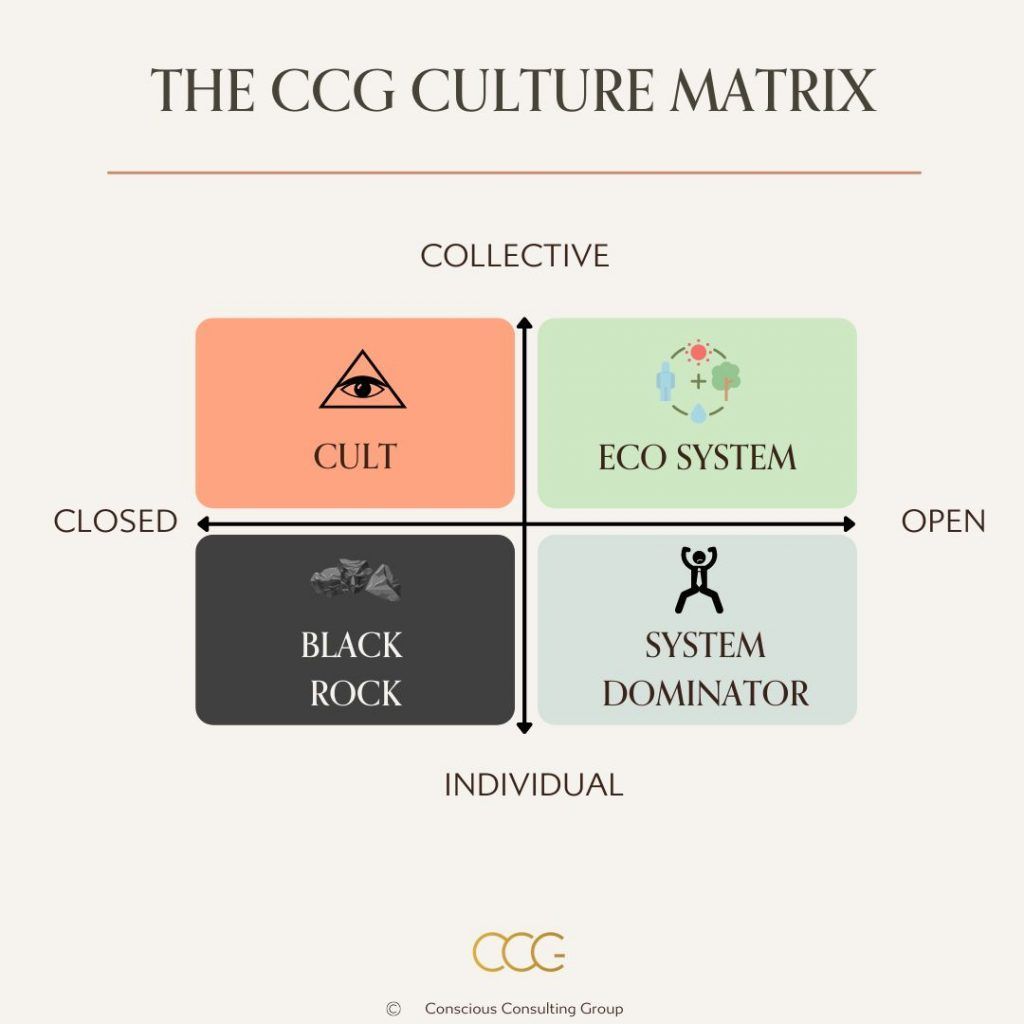Blog

Julia Culen
The Culture Matrix: a simple tool for a difficult conversation

What if Culture was a deliberate strategic choice and not a some higher mythical power? And what if Culture was not eating Strategy for breakfast but if the 2 were co-arising as result of a clear intention?
For the sake of facilitating the opaque culture discussion for my clients, I created a simple model that is easy to grasp and proved to be a good starting point for a high-level strategic culture discussion.
The Culture Matrix
This matrix describes 4 different types of cultures along 2 dimensions: open vs closed and individual (me) vs collective (we). These dimensions are commonly used for describing political paradigms of societies and country cultures and I find them equally useful to distinct corporate cultures.
The naming for the culture types – Cult/Sacred Community, Eco System, System Dominator and Black Rock – is based on the key characteristic of each model.
Each of the four culture type distinct from the other in several dimensions.
Her is a summary and table to distinct each of the types:
1. Eco System
Eco systems are typically organized as platforms with the purpose and intention to create synergies within and beyond their direct are of control. They use network effects (friends of friends of friends) and invitations for engagement with their offerings to increase their impact. The key secret of Eco Systems is to not only care for the own well-being at the cost of others, but to “grow the cake together” by creating win-win-win situations: for oneself, for partners and customers. The boundaries are blurry and the action takes place in a mindset of collaboration, co-innovation and trust. Assets can only grow and thrive when shared across the Eco-System.
Leadership and Authority are shared across the Eco-System with the result of shared responsibility and ownership and also distributed risk, rather than entrusting everything a small group of Leaders who dominate everything, which is a cluster-risk in a complex and volatile world. Governance is exerted and the rules of the came and context Leadership are still in place to create a safe and clear space to operate in.
2. System Dominator
As the name suggests, System Dominators act within a larger Business Eco-System with their suppliers, like in the automotive or Grocery Chains like REWE. Yet they operate in a mindset of domination and power play, trying to keep control over prices to keep them low and get the largest piece of the cake.
Systems Dominators are based on competition, division and domination to stay ahead of their suppliers. They don’t genuinely care about the well-being of their system, but basically fight for their own survival a the cost of others. Their internal cultures are often as toxic and based on individual performance, but rely on team work too. Lately these organizations experiment with agile and self-organizations as they see the limits of their current approach when it comes to dealing with a VUCA world.
This sounds rather dark, but actually this is the most common Culture when it comes to bigger Corporations.
3. Black Rock
Black Rock type organizations can seem opaque with strong external boundaries to the outside. These Organizations operate in Silos and oftentimes with Chinese Walls inside the organization. There is little transparency how they operate, they safeguard patents or have very strong connection with political leaders. The incentive system is based on individual performance and encourages competition between employees. Sometimes they have work-contracts that oblige them to never talk about their company. We see some big tax advisory companies in this category, but also Investment or Private Equity firms in this arena. Some could have aspects of Cults.
4. Cult / Sacred Communities
Sacred Communities have strong boundaries to the outside world, but are very community and “we” focused. Movies like “the firm” perfectly show-cased a corporate culture, that emphasizes the “we are family” idea by making a strong distinction whether you are in-or-out. Some Institutions or Clubs are organized like this, but it could also be political parties, Non Profit Organizations that are strongly value-based or Consulting Companies like McKinsey or Apple. People inside these organizations gain identity from feeling a sense of superiority vs non-members: be it by being smarter, richer or more ethical.

Making use of the model
I use our 3 step transformational model:
- Becoming aware: each persons marks a point on the Matrix for the organization in question. Then share in the group and explain why you think what you think. See where are the differences and commonalities. You will be amazed how different the result will be
- Setting intentions: Now have each person chose a spot on the Culture Matrix that they would find ideal for your respective organization and WHY.
- Creating new conditions: Think about ways to get there and what one next step could be.
Closing remarks:
This model, like any model, marks some extreme points and real life is never black or white. Most organizations are a mixture of different models, but certainly have one dominant inclination. So I suggest to use it in a playful way!
